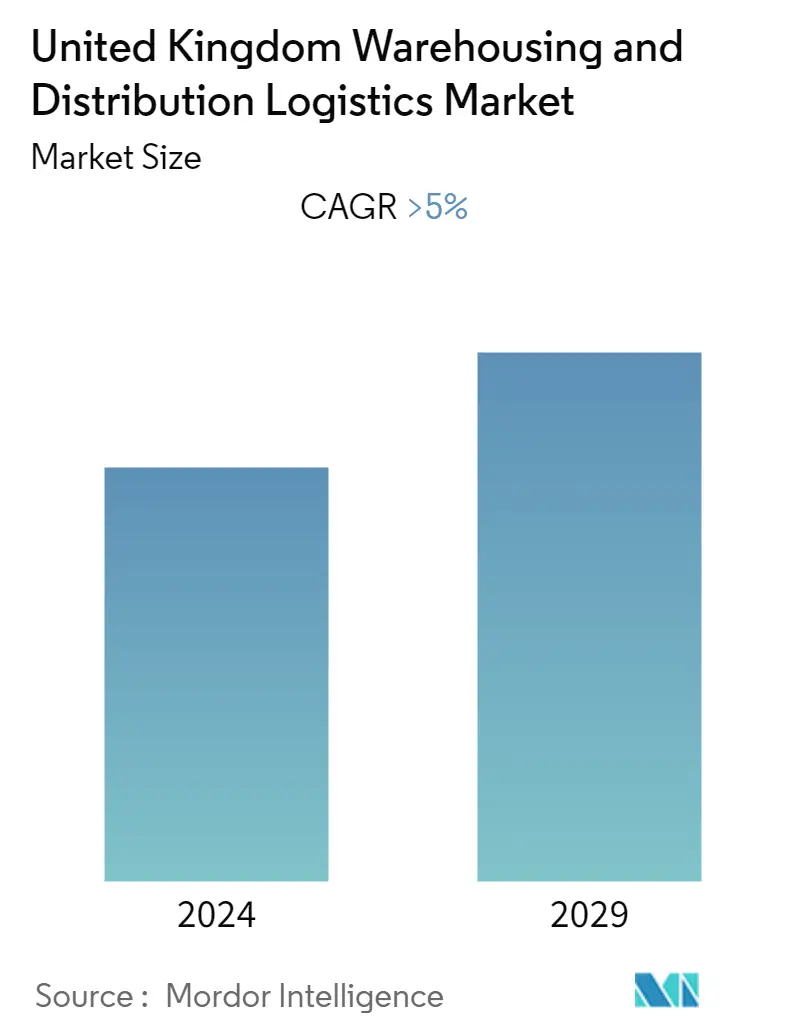Market Size of United Kingdom Warehousing and Distribution Logistics Industry

| Study Period | 2019 - 2029 |
| Base Year For Estimation | 2023 |
| Forecast Data Period | 2024 - 2029 |
| Historical Data Period | 2019 - 2022 |
| CAGR | 5.00 % |
| Market Concentration | Low |
Major Players
*Disclaimer: Major Players sorted in no particular order |
UK Warehousing & Distribution Logistics Market Analysis
During the time frame of the forecast, the UK warehouse and distribution logistics market is expected to register a CAGR of more than 5%.
- COVID-19 pretty much brought the global flow of goods to a virtual standstill. Industries of all descriptions found it difficult to procure goods. Strict enforcement of border controls led to backups and delays. COVID-19 caused business revenues to plummet, and the market took a hit.
- Over the last decade, the number of logistics facilities in the UK has doubled. This prolific growth is perhaps best characterized in the Midlands, the region with the most concentrated number of logistics and warehouse providers in the UK. Additionally, parts of the East of England and Yorkshire and Humberside, regions not traditionally considered to be major logistics hubs, are now major sectoral logistics powerhouses.
- Britain's decision to leave the EU and the COVID-19 pandemic forced businesses in a wide range of industries to change how they do business. This led to the need for more warehouse space. In the Midlands, for example, 90% of the British population lives within a four-hour drive, which made it easy for businesses to store and ship goods anywhere in the UK quickly and efficiently. This made supply chains more efficient. In 2021, the number of transport and storage businesses was 88% higher than in 2011.
- Even though it has grown a lot over the last ten years, transport and storage are still a small industry in the UK. According to the Office of National Statistics (ONS), in 2011, there were approximately 17,000 postal and courier depots in the UK. By 2021, this number had grown by 147%, to 42,500. A big part of this growth came from the West Midlands.Couriers and haulers have been the main drivers of transport and storage growth over the past ten years. Also, after Britain left the EU, 69% of businesses in the transportation and storage industries said they used a wider range of suppliers.
- Because there are so many different kinds of distribution services and commercial transportation options are always changing, businesses need more cost-effective, flexible, and custom ways to handle logistics and warehouse storage. Also, this trend seems likely to keep going in the years to come, since eCommerce is still growing and some local businesses are closing down as people continue to look for better deals online than in person.
- The UK has high labor costs and a high rate of e-commerce. For example, per warehouse, the UK spends much more than the average country in the world. This makes it a prime market for warehouse automation. UK consumers have been buying things online for a long time and expect extremely fast (and free) delivery-something that requires levels of efficiency that can only be achieved with automation. Therefore, the UK has been faster to adopt e-commerce than other comparable European nations.
- But the figures are stark: in France, the e-commerce spend per warehouse was USD 20.2 million in 2021; in Italy, it was USD 8.8 million; and the UK has the world's highest at USD 36 million. When it comes to the overall size of the warehouse automation market, Germany and the UK will lead Europe in 2020. According to industry estimates, the UK will have Europe's largest warehouse automation market at USD 3.9 billion by 2025, at which point its market will be USD 900 million larger than Germany's.
UK Warehousing & Distribution Logistics Industry Segmentation
Warehousing is one of the most important parts of this rapidly growing industry. It is mainly about storing goods that are going to be moved, either in or out.Distribution has to do with managing the flow of goods between where they are made and where they are used.The core objective of the warehouse and distribution logistics sector is to send the right product to the right destination on time, on budget, and with end-to-end visibility.
The UK warehousing and distribution logistics market is split up by end user, which includes manufacturing, consumer goods, food and beverage, retail, healthcare, and other end users. For all of the above segments, the report gives market size and forecasts in terms of value (in USD billion) for the UK warehousing and distribution logistics market.
| By End-User | |
| Manufacturing | |
| Consumer Goods | |
| Food and Beverage | |
| Retail | |
| Healthcare | |
| Other End-Users |
United Kingdom Warehousing and Distribution Logistics Market Size Summary
The UK warehousing and distribution logistics market is experiencing significant growth, driven by factors such as the rise in e-commerce and the need for efficient supply chain solutions. The market has seen a substantial increase in logistics facilities over the past decade, with regions like the Midlands becoming key hubs due to their strategic location. The impact of Brexit and the COVID-19 pandemic has further accelerated the demand for warehouse space, as businesses adapted to new trading conditions and increased online shopping. This shift has led to a surge in new warehouse construction projects, particularly in regions like the East Midlands, Yorkshire, and the East of England. Despite the growth, the transport and storage sector remains relatively small compared to other industries in the UK, but it is poised for further expansion as businesses seek more cost-effective and flexible logistics solutions.
The UK is also at the forefront of warehouse automation, driven by high labor costs and the need for rapid e-commerce fulfillment. The market is characterized by a high level of competition among global and regional players, with companies like DHL, DB Schenker, and CEVA Logistics leading the charge. The adoption of automation technologies is expected to increase, as businesses look to enhance efficiency and reduce reliance on human labor. The market's fragmentation and competitive nature have led to strategic partnerships and technological innovations aimed at gaining a competitive edge. As the demand for warehousing continues to rise, driven by ongoing e-commerce growth and changing consumer behaviors, the UK warehousing and distribution logistics market is set to expand further, with automation playing a crucial role in its evolution.
United Kingdom Warehousing and Distribution Logistics Market Size - Table of Contents
-
1. MARKET INSIGHTS
-
1.1 Current Market Scenario
-
1.2 Value Chain / Supply Chain Analysis
-
1.3 Technological Developments in Warehousing
-
1.4 Government Regulations
-
1.5 Insights into Warehousing Rents
-
1.6 Insights into General Warehousing
-
1.7 Insights into Dangerous Goods Warehousing
-
1.8 Insights into Refrigerated Warehousing
-
1.9 Insights into Effects of E-commerce Growth
-
1.10 Insights into Free Zones and Industrial Parks
-
1.11 Impact of COVID-19 on the Market
-
1.12 Market Dynamics
-
1.12.1 Market Drivers
-
1.12.2 Market Restraints
-
1.12.3 Market Opportunities
-
1.12.4 Industry Attractiveness - Porter's Five Forces Analysis
-
1.12.4.1 Bargaining Power of Buyers/Consumers
-
1.12.4.2 Bargaining Power of Suppliers
-
1.12.4.3 Threat of New Entrants
-
1.12.4.4 Threat of Substitute Products
-
1.12.4.5 Intensity of Competitive Rivalry
-
-
-
-
2. MARKET SEGMENTATION
-
2.1 By End-User
-
2.1.1 Manufacturing
-
2.1.2 Consumer Goods
-
2.1.3 Food and Beverage
-
2.1.4 Retail
-
2.1.5 Healthcare
-
2.1.6 Other End-Users
-
-
United Kingdom Warehousing and Distribution Logistics Market Size FAQs
What is the current United Kingdom Warehousing and Distribution Logistics Market size?
The United Kingdom Warehousing and Distribution Logistics Market is projected to register a CAGR of greater than 5% during the forecast period (2024-2029)
Who are the key players in United Kingdom Warehousing and Distribution Logistics Market?
DHL Group, CEVA Logistics, Kuehne+Nagel, DB Schenker and Rhenus Logistics are the major companies operating in the United Kingdom Warehousing and Distribution Logistics Market.

